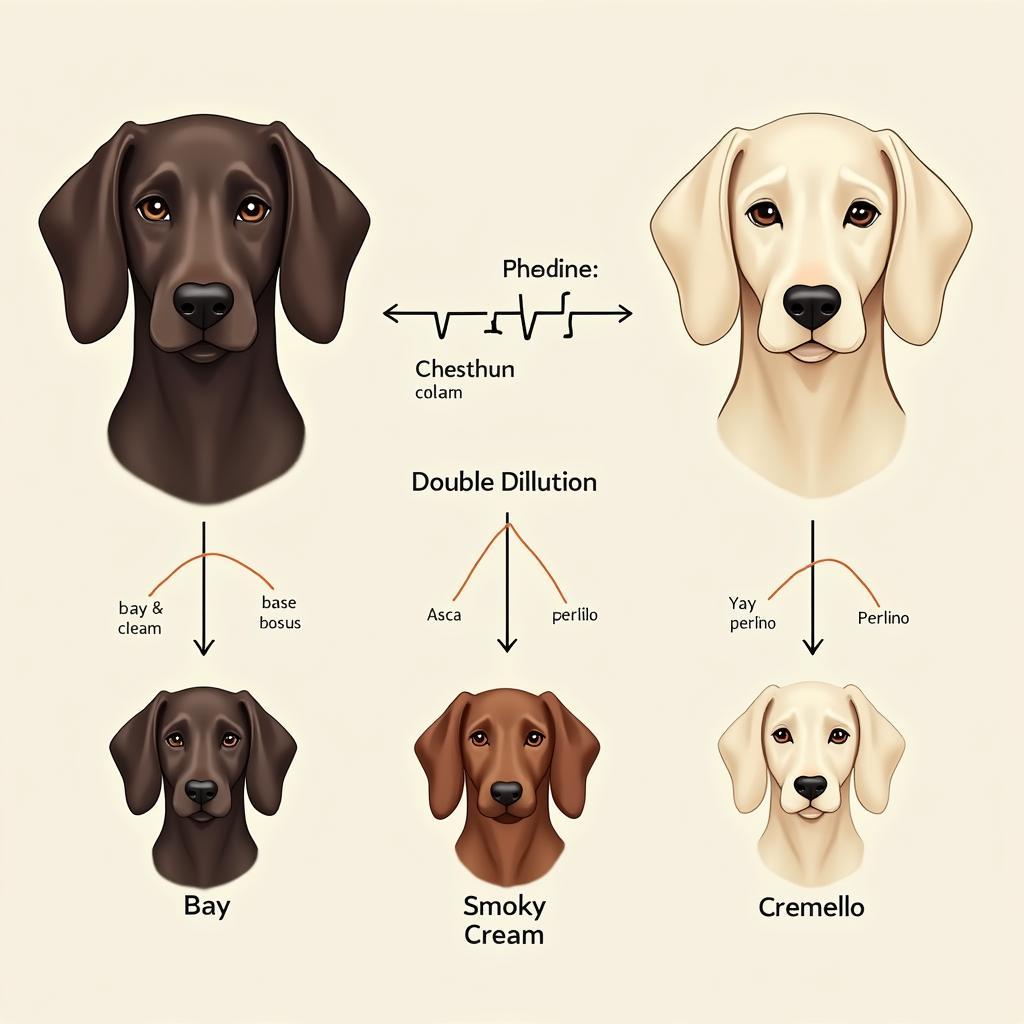Double Dilute Horses are fascinating creatures, captivating horse lovers with their unique coat colors and often striking blue eyes. These captivating equines are the result of specific genetic combinations that “dilute” the base coat color, creating a spectrum of pale shades. This article delves into the genetics behind the double dilute horse, exploring the health considerations associated with these beautiful animals and addressing common misconceptions.
Decoding the Genetics of the Double Dilute
The creation of a double dilute horse involves two cream dilution genes. A horse inherits one cream gene from each parent, resulting in a “double cream” or “homozygous cream” genotype. These genes act on the base coat color—bay, black, or chestnut—to lighten and soften the pigment. The specific base color under the double dilution influences the final coat color. For instance, a chestnut base with two cream dilutions produces a cremello, recognizable by its creamy white coat and pink skin. A bay base results in a perlino, showcasing a pale, almost apricot hue. And a black base creates a smoky cream, with a light grey or silvery coat.
What makes double dilutes so intriguing is the complete transformation of the base coat. The cream dilution genes are remarkably powerful, often masking the original color almost entirely. This leads to the stunning array of pale coat colors that distinguish these horses.  Genetics of Double Dilute Horses
Genetics of Double Dilute Horses
Unveiling the Different Double Dilute Colors
Several striking coat colors arise from double dilution. Cremellos, with their pure white coats, pink skin, and blue eyes, are perhaps the most readily recognized. Perlinos, a bit darker than cremellos, display a soft, yellowish-white or apricot hue. Smoky creams, derived from a black base, can range from a light grey to a silvery off-white. These variations showcase the interplay between genetics and base coat color.
Health Considerations for Double Dilute Horses
While aesthetically pleasing, double dilute horses can be prone to certain health issues. One concern is photosensitivity, due to their reduced pigment. This can lead to sunburn and skin irritation, requiring careful management and protection from the sun. Another condition associated with double dilution is Multiple Congenital Ocular Anomalies (MCOA), which can affect vision. perlino horse vs cremello Responsible breeders conduct thorough genetic testing to minimize the risk of these conditions.
“Regular veterinary check-ups are crucial for double dilute horses,” advises Dr. Amelia Shepherd, Equine Veterinarian and Genetic Specialist. “Early detection and proactive management can significantly improve the horse’s quality of life.”
Managing Sun Sensitivity in Double Dilutes
Protecting double dilute horses from the sun’s harmful rays is paramount. This involves providing ample shade, utilizing UV-protective fly sheets and masks, and applying sunscreen specifically formulated for horses. During peak sun hours, limiting turnout can further mitigate the risks associated with photosensitivity.
Dispelling Myths about Double Dilute Horses
One common misconception is that all double dilutes are albinos. This is not true. Albinism is a completely separate genetic condition that results in a complete lack of pigment. Double dilutes, while pale, still have pigment in their skin, hair, and eyes.
“The term ‘albino’ is often misused when describing double dilutes,” clarifies Dr. Samuel Evans, Equine Geneticist. “It’s important to understand the distinct genetic differences between these conditions.”
Another myth is that double dilutes are inherently weaker or less athletic. This is also untrue. Their coat color has no bearing on their overall strength or athletic ability. Like horses of any color, their performance depends on individual genetics, training, and overall health.
Conclusion
Double dilute horses are a testament to the fascinating world of equine genetics. Their unique coat colors, resulting from the interplay of cream dilution genes and base coat colors, make them a captivating sight. While they may require specialized care due to potential health concerns, responsible ownership and proactive management can ensure these beautiful animals thrive. Understanding the genetics and specific needs of double dilute horses allows us to appreciate their unique beauty and provide them with the care they deserve.
FAQ
- Are double dilute horses always white? No, they can be cremello (creamy white), perlino (apricot), or smoky cream (light grey/silver).
- Are double dilutes albinos? No, albinism is a different genetic condition.
- What health problems can double dilutes have? Sun sensitivity and MCOA are potential concerns.
- How can I protect a double dilute horse from the sun? Provide shade, use UV-protective gear, and apply sunscreen.
- Are double dilutes less athletic? No, their coat color doesn’t affect their strength or athleticism.
- What causes the double dilute coat color? Two cream dilution genes inherited from each parent.
- What are the different base coat colors that can be diluted? Bay, black, and chestnut.
For any questions or concerns regarding double dilute horses or other equine matters, please don’t hesitate to contact us. Phone: 0772127271, Email: [email protected] Or visit us at: QGM2+WX2, Vị Trung, Vị Thuỷ, Hậu Giang, Việt Nam. We have a 24/7 customer service team.